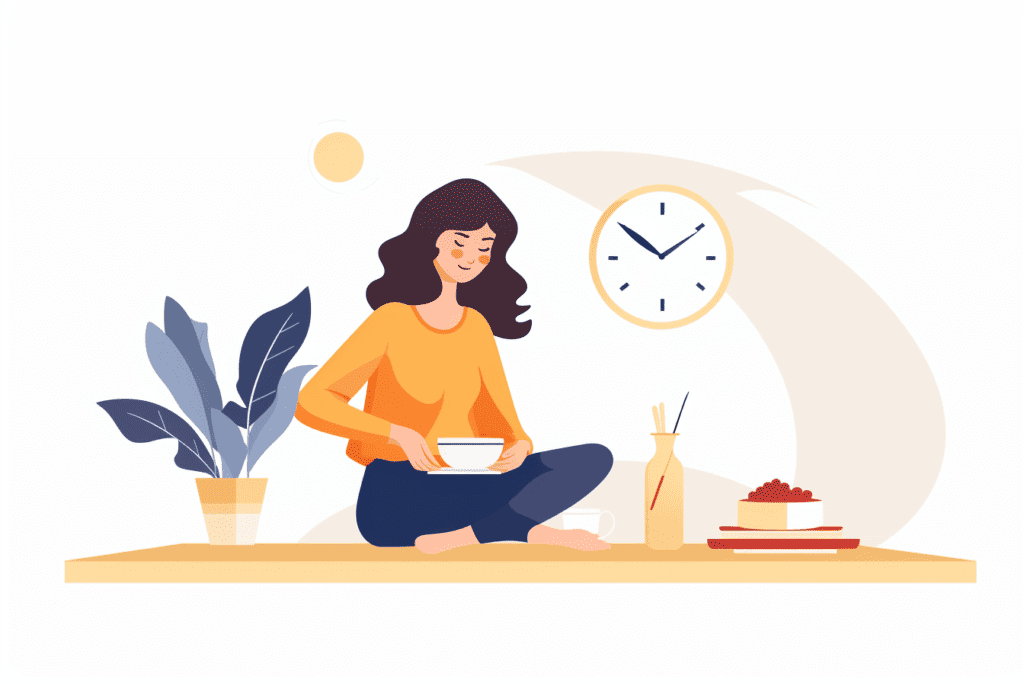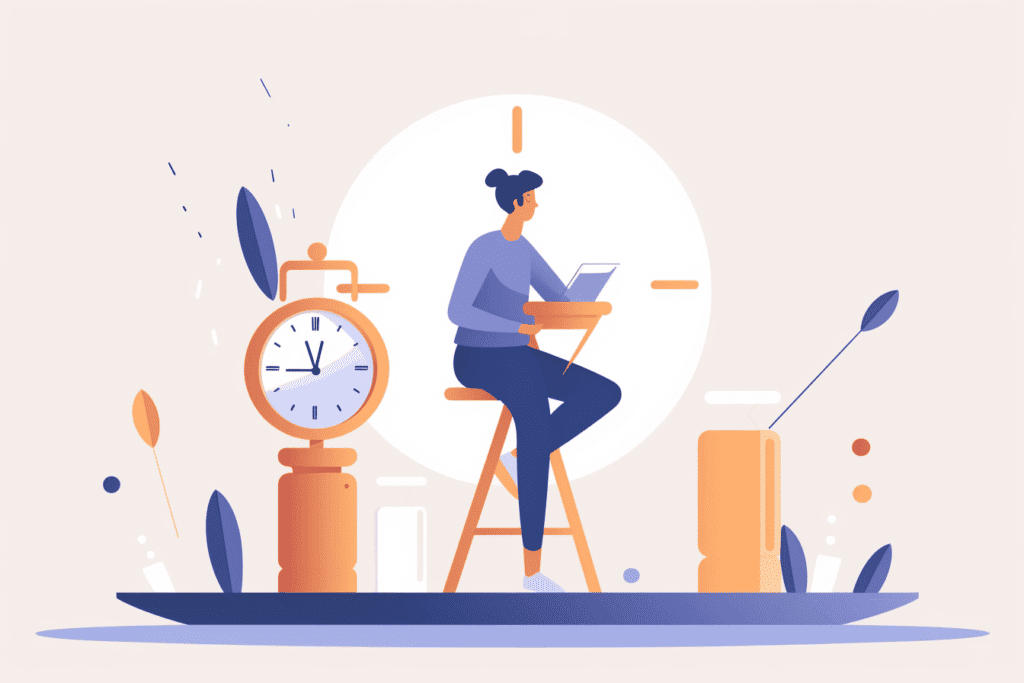How to Stick to a Routine with ADHD
Let’s begin this post with a simple question: How many times have you launched a new routine, only to see it crumble after a few days?
Oops, right?
If you’re an adult with ADHD, you’re no stranger to the love hate relationship with routines.
You want that rock-solid routine, but turning it into reality? Often feels like chasing a unicorn.
That’s why in this blog post, I’ll guide you through tips for creating and maintaining daily routines and habits. We’re going to talk about specific strategies that play into those unique strengths of ADHD brains.
If you’re tired from the ongoing ADHD struggle to get things done and yearn for a reliable routine, read on. I’m about to lay out how to flip your mindset, build long lasting habits, and ultimately give your overall well-being a power-up.
First let’s discuss the following: Why routines are so damn hard to keep? And exactly how to stick to a routine with ADHD?
Why is Routine a Challenge for People with ADHD
Imagine trying to steer a boat in rough seas. Sounds tricky, right? That’s often how it feels for people with ADHD when it comes to sticking with a routine.
ADHD, also known as Attention Deficit Hyperactivity Disorder, can make it tough to focus, manage time, and stay organized. It’s like having a bunch of internet tabs open all at once and not being able to pick which one to pay attention to.
That’s why people with ADHD can find it hard to use their time well, which makes it a big challenge to set and keep a routine.

Creating and sticking with routines often feels like a big mountain to climb for those with ADHD.
The natural traits of ADHD, like being easily distracted, impulsive, and inconsistent, make it even harder to stick to routines.
Adults with ADHD can often get pulled off track by new, more exciting things, which makes it difficult to stick with a regular, structured routine. They’re also more likely to forget parts of their routine or make impulsive choices that mess up their plan.
Plus, the constant effort it takes to stick to a routine can be really tiring for people with ADHD, which makes it more likely they’ll give up on the routine. This cycle of struggle and frustration makes the challenge of keeping a routine even tougher for them.
So…Should We Ditch Routines Altogether?
You might wonder, “If it’s so hard to maintain routines are for people with ADHD, should we just skip routines altogether?”
Well, not so fast!
Let’s clear up this idea.
Even though adhering to a routine can be hard for those with ADHD, this doesn’t mean routines are bad or impossible. On the contrary, a good routine can provide a sense of order and predictability, and can be a fantastic way to manage ADHD symptoms.

Routines Can Help Your ADHD Brain Stay Focused
You see, routines can help lighten the load of decision-making. It’s like having a GPS that guides you through your day, making sure you don’t miss any turns or important stops.
The trick is to create a routine that isn’t rigid or boring, but one that flexes with you and plays to your strengths. So yes, building and maintaining a routine might be a tough trek, but it’s one that’s well worth the effort.
Related: AI Scheduling Assistant Tools

10 Tips for Sticking to a Routine with ADHD
1. Design a Flexible Schedule
When creating a routine, avoid rigid structure and leave room for flexibility. The ADHD brain thrives on novelty, so allowing room for spontaneity and adaptability can prevent boredom and overwhelm.
Build in breaks, change up your tasks, and find ways to inject variety into your routine to keep things engaging and enjoyable.
For example, if you usually schedule time for a workout in the morning, but you overslept, you should be able to move it to the afternoon. This avoids the “all or nothing” thinking that can often disrupt routines for people with ADHD.
2. Break Tasks Down into Smaller Steps
Large tasks can cause stress and disrupt focus, especially for adults with ADHD. Breaking these tasks down into smaller steps can make them less overwhelming and easier to tackle.
Use the Principle of “Eating the Elephant”
There’s a principle that aligns perfectly with this strategy. The idea is, if you were given an elephant to eat, the task would seem insurmountable. But if you break it down into smaller parts, it becomes achievable.
In the context of dealing with ADHD, that ‘elephant’ could be a large task or project that feels overwhelming. If you take the ‘eat the elephant’ approach, you divide this mammoth task into smaller, more manageable ‘bites’. Each ‘bite’ is a task you can accomplish in a single work session or day, making the overall project less intimidating and easier to tackle.
For example, instead of viewing “clean the house” as a single task, create a list with set tasks like “clean the kitchen” or “vacuum the living room”.
3. Use Visual Reminders
Visual aids are extremely useful tools for adults who have ADHD. They help in completing tasks efficiently. You can use anything for a visual aid – it could be simple sticky notes, a large whiteboard, or even a digital task manager such as blocking time on Google Calendar.
One of the ways to use a visual aid is to set alarms on your phone or computer. These alarms will remind you it’s time to start a new task.
This method helps to keep you on track and focused on your routine. It reduces the chances of you forgetting about a task or getting distracted by other things.

Practical Example of Using Visual Reminders for ADHD
Let’s consider Jane, a software developer diagnosed with ADHD. She often struggles to maintain focus and manage her tasks effectively, which impacts her productivity. Here’s how she uses visual reminders to stay on track:
Jane has a large whiteboard by her work desk, where she charts out her weekly tasks. She uses color-coded markers for different types of tasks: red for urgent, blue for ongoing projects, and green for personal tasks. Each morning, she reviews the board, prioritizing her tasks for the day.
She also uses a digital task manager, setting specific alarms for each task. For instance, an alarm for ‘Start working on Project X’ is set for 10 am, and another for ‘Attend team meeting’ at 2 pm. Her phone and computer send notifications at the set times, serving as an additional reminder.
Moreover, Jane keeps a sticky note on her laptop saying, “Is what you’re doing now productive?” This note serves as a constant reminder for Jane to stay focused on her work and resist the temptation of distractions. Through these visual reminders, Jane has found a strategy that aids her in managing her tasks effectively despite her ADHD.
4. Create Your Morning Routine

If you have ADHD, having a morning routine can help you feel more organized and ready to face your day.
A key part of your morning should be a healthy breakfast. Eating food that’s high in protein and low in sugar can give you energy and help you stay focused.
Also, remember to drink lots of water. Water can help your body in many ways, like aiding digestion and boosting your metabolism. You could even try drinking lemon water to get some extra vitamin C!
But, routines doesn’t mean your mornings have to be boring.
Change things up now and then. Eat different things for breakfast, mix up your exercise activities, or meditate on some days.
A routine is supposed to help you feel more structured, but it shouldn’t stop you from being creative or flexible.
5. Get a Good Night Sleep

ADHD can often mess with your sleep. Studies show that as many as 75% of adults and kids with ADHD have some kind of sleep disorders – maybe you struggle to drift off at night, or you find it hard to stay asleep.
This could be because, with ADHD, your mind and body are so active that it’s tough to wind down and get to sleep.
But sleep is extremely important, especially when you have ADHD. When you’re sleeping, your body is busy repairing and restoring itself – this includes consolidating memories and regulating emotions, which can be tricky areas for people with ADHD. If you’re not getting enough good quality sleep, you might find these areas even more challenging. But the good news is, if you can improve your sleep, you can also improve your focus, impulsivity, and emotional management, which can make living with ADHD a bit easier.
Pro Tip: How to Establish a Consistent Bedtime Routine
Establishing a consistent bedtime routine can help signal your body that it’s time to wind down and get ready for sleep. Here are some actionable steps to consider:
- Set a consistent bedtime and wakeup time: Aim to go to bed and wake up at the same time each day, even on weekends. This consistency can help regulate your body’s internal clock and optimize the quality of your sleep.
- Create a pre-sleep ritual: Engage in quiet, calming activities before bed such as reading a book, taking a warm bath, or practicing mindfulness exercises. This ‘wind-down’ period can help separate your sleep time from activities that can cause excitement, stress or anxiety.
- Limit exposure to screens before bed: The light emitted by an electronic device – phones, tablets, computers, and TVs can interfere with your body’s production of melatonin, a hormone that regulates your sleep-wake cycle. Try to turn off these devices at least an hour before going to bed.
- Optimize your sleep environment: Make sure your bedroom is dark, quiet, and cool. Consider using room-darkening shades, earplugs, a fan, or other devices to create an environment that suits your needs.
6. Incorporate Physical Activity into Your Routine
You’ve probably heard it countless times – regular exercise can work wonders for managing adult ADHD symptoms and enhancing your focus. But let’s be honest, the idea of joining a gym or committing to a rigorous fitness routine can feel overwhelming.
The good news is, you don’t have to run a marathon or become a CrossFit enthusiast (unless that’s what you’re into). Even a simple morning stroll, a quick 10-minute yoga session, or any other enjoyable low-key physical activity can make a significant difference. So, find what works for you and embrace the benefits it brings.
Forget the “all or nothing” mentality. When it comes to fitness, there’s no such thing as perfection, and small steps definitely count. Consistency trumps intensity every time.
Looking for more ways to get moving? How about sprucing up your workspace?
Standing desks or sit-stand workstations can encourage you to move more and help offset the negative impacts of being a desk jockey.
A wearable fitness tracker, like a Fitbit, can remind you to get up, stretch, or take a quick walk.
Trust me, those bits of movement will add up and play a big part in boosting your energy and sharpening your focus.
7. Embrace Mindfulness

Breathe in, breathe out. Sounds simple, right? But this little trick can do wonders for your stress levels.
Whether you’re stuck in traffic, in between meetings, or just need a moment, take some time to do some deep breathing exercises.
These quick and easy practices can help you find your zen and make sticking to your routines a whole lot easier.
Mindfulness Techniques for ADHD
- Body Scan: This technique involves mentally scanning your body from head to toe, noting any sensations, tension, or discomfort. This exercise can help ground your attention in the present moment and reduce impulsivity.
- Breathing Exercises: One simple technique is the 4-7-8 breathing method. Breathe in for a count of 4, hold your breath for a count of 7, and exhale for a count of 8. This method helps to slow your heart rate and calm your mind.
- Guided Imagery: Imagine a peaceful place or situation. Try to use all your senses to make the imagery as vivid as possible. This method can help in diverting your mind from distractions and increasing focus.
- Mindful Walking: While walking, focus on the sensation of your feet touching the ground, the rhythm of your breath, and the feeling of the wind against your skin. It brings your attention back to the present moment and away from distracting thoughts.
- Mindful Eating: Pay attention to the taste, texture, and smell of the food. Eat slowly to fully savor each bite. This practice can help improve focus and reduce impulsive eating often associated with ADHD.
Remember, it’s normal for your mind to wander while practicing these techniques. When this happens, gently guide your focus back without judging yourself. Over time, these mindfulness techniques can help manage ADHD symptoms by improving your ability to control your attention.
8. Use Timers

Timers can be a practical tool in managing ADHD symptoms and improving focus as they provide tangible reminders of the passage of time. Here are a few tips to effectively use timers:
- Pomodoro Technique: This time management method involves breaking your work into intervals, typically 25 minutes, separated by short breaks. It’s an effective way to keep your focus sharp and prevent burnout.
- Time Blocking: Dedicate specific time blocks for different tasks throughout your day. This method helps in maintaining focus on one task at a time and prevents multitasking, which can be a challenge for individuals with ADHD.
Use Digital Tools
Several digital platforms can help you in maintaining focus and managing time effectively:
- FocusMate: This virtual co-working service helps you stay accountable by pairing you with a ‘focus mate’. You and your partner keep your video on while working silently, creating an atmosphere of productivity.
- Time Doctor: An AI-powered time tracking tool, Time Doctor, provides detailed insights into how you spend your time. It can help identify patterns and areas for improvement.
- Rize: Another AI time management tool – Rize uses artificial intelligence to track and analyze how your time is spent. By providing an in-depth breakdown of your daily activities, it aids in identifying distractions, optimizing productivity, and enhancing focus.
Also Read: Best AI Time Tracking Tools
9. Reward Yourself
Let’s not forget about the power of a good reward.
For adults with ADHD, rewards are a secret weapon. Maintaining a regular routine can feel like climbing Everest – that’s the ADHD life. But rewards can help giving you a little boost to stick to everyday habits and get things done.
Remember, your reward doesn’t have to be a big holiday or a shopping spree (though that sounds nice!). It’s the small joys that make a big difference.
Think about relaxing with a podcast, enjoying a fancy coffee, or taking a neighborhood stroll. These little rewards make you feel great and keep those helpful habits on track, giving you a sense of achievement.
Imagine this – every time you finish a task or keep up with a routine, link it to something that makes you happy.
Nailed your morning routines for a week? How about a cozy movie night as a reward?
Stayed focused on work without getting distracted? Treat yourself to a snack you love.
This approach makes the journey fun and reinforces the habit, helping you maintain a structured routine even when ADHD throws you a curveball.
10. Ask for Support
And last but not least, don’t forget it’s totally okay to ask for a helping hand. Whether it’s advice from your pal, a close family member, or even your favorite coach, they can be the cheerleaders in your corner, helping you stay on track.
Check out online communities as well. Take a look at the ADHD subreddit (r/ADHD) or the ADD Forums – they’re buzzing with people sharing their experiences, asking for advice and learning together as they juggle life with ADHD.
And if you feel like you need something a little more professional, there are online mental health platforms like Talkspace or BetterHelp. They’ve got legit therapists available for digital sessions. So remember, you’re not alone on this ride – there’s a whole load of resources to help you navigate life with ADHD.
Final Thoughts
Building a daily routine when you’ve got ADHD isn’t about scaling Everest in a day. It’s about taking baby steps, like setting up a steady schedule, eating regular meals, locking in some chill-out time, and getting a good night’s sleep. And hey, why not try out some visual planners or digital calendars to keep your life organized?
But, let’s not forget about celebrating the small wins, because they matter! Every time you check something off your to-do list or stick to your routine, give yourself a pat on the back. It’s these little victories that give us the motivation to keep going.
Living with ADHD isn’t a walk in the park, and it’s definitely not a sign of weakness. In fact, it showcases your incredible strength and resilience. Each day, you’re navigating through challenges most people can’t even imagine.
So, on those tough days when you’re feeling worse, remember to cut yourself some slack. You’re making progress, even if it doesn’t always feel like it. Remember, every victory, no matter how tiny it seems, is a big deal. So, go ahead and celebrate you!







